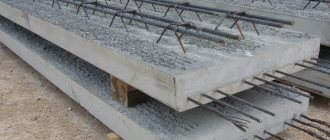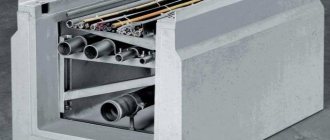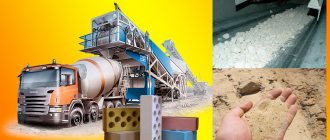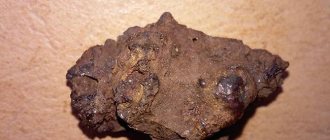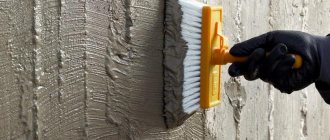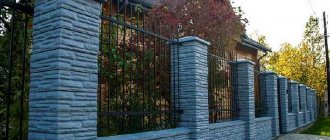Concrete-mortar units are specialized installations that are designed for producing concrete. The use of automation methods in the operation of these units greatly reduces labor costs for the implementation of the technical process.
The use of a large number of variable parameters makes it possible to produce concrete mixtures with different preparation recipes. A concrete mixing unit with minimal use of production space and high equipment reliability ensures highly efficient production of building mixtures in large volumes.
This is also facilitated by increased resistance to external factors.
Equipment
A concrete unit includes several main components and assemblies.
The main components of this equipment are:
- A container whose purpose is to store additives and various components used in the preparation of a concrete mixture. This BSU component is additionally equipped with specialized dosing equipment and sensors.
- Bunker of a concrete mixing plant. The main function of this element is to prepare a concrete mixture.
- A tank for the necessary water supply and a special filter system.
- Remote control and control of the operation of units and assemblies of the installation.
- Transport module. Depending on the model, this installation component can be of different types.
- Containers designed for storing components used in the production of concrete mixtures.
- Vibration modules.
Blocks for preparing concrete mixtures are a fairly complex technical device - a compact line with a complete production cycle.
Selection criteria
To correctly select a concrete mixing plant, you should be guided by a wide list of rules and recommendations:
- For enterprises with a limited number of service personnel, the best option would be a mortar-concrete unit with a maximum degree of automation. This will help one operator at a central control panel to monitor all process parameters and control the operation of production equipment.
- When purchasing a concrete unit, you should take into account the possibility of upgrading it and equipping it with auxiliary devices, which will help in the future to optimize the operation of the installation without significant financial costs.
- The availability of warranty and service will free users from solving problems with the setup and breakdown of expensive technological equipment.
- Mobile control unit is the optimal solution for construction companies carrying out work at sites at different addresses. Stationary installations are the privilege of companies selling ready-mixed concrete and manufacturing reinforced concrete products.
- The gravity type of mixer works effectively with plastic solutions, but does not cope well with other types of homogeneous building mixtures. The presence of forced mixing makes it possible to produce concrete of any grade and density, but this increases the cost of electrical energy.
- For the production of concrete mixtures at subzero ambient temperatures, only all-season installations with a heating system and a thermal insulation shell are suitable.
- The presence of containers for storing concrete fillers with different fractions significantly expands the scope of use of the concrete mortar unit and makes it possible to produce mortar of various grades, densities and types.
In each specific case, you should take an individual approach to the selection of production equipment, guided by numerous technical parameters, design solutions and budget size.
« to the list of articles
Types of BRU
BRUs are characterized by a wide range of different design features, which are used as criteria for dividing production plants into several types.
All BSU can be divided into the following groups:
- According to the level of mobility.
- According to the duration of the technological cycle.
- According to the seasonality of equipment operation.
According to the degree of mobility, equipment is divided into stationary BSU and mobile mini-installations. Stationary equipment is used for installation in specialized factories for the production of building mixtures. Such a system is characterized by a high level of performance. Mobile systems are used when there is a need to regularly move a construction site to a new location.
RBU can be divided into 2 types depending on the operating mode - continuous and cyclic. Concrete units of cyclic type carry out step-by-step execution of all operations in the production cycle.
Continuous batching plants have a high productivity rate, but they cannot be used if there is a need for frequent adjustments to the mixture preparation recipe.
The concrete unit may differ in design. There are summer and winter or all-season mixing blocks, the latter are equipped with body insulation. Additionally, a heating system can be installed on winter versions of the equipment.
A separate criterion is the level of use of automation in the technological cycle, but BSU manufacturers offer consumers the opportunity to carry out subsequent modernization, even if they purchase an inexpensive and simple installation for the production of mortar.
Concrete unit or RBU (BSU) - what is it?
Home / Articles / Concrete unit or RBU (BSU) - what is it?
For decades, concrete has remained the main building material. The efficiency of developers directly depends on the quality of concrete mixtures. Moreover, the delivery of concrete to a construction site must be carried out uninterruptedly. To ensure construction with the required volume of high-quality concrete and on time, developers prefer not to use the services of concrete plants, but to build their own concrete units. A concrete unit is a complex consisting of cement warehouses, inert materials warehouses and concrete mixing plants. Concrete units significantly increase the efficiency and profitability of construction. Manufacturers of concrete units are Russian and foreign companies, for example, German, Italian, French, Chinese, etc. Concrete units are produced in different configurations: standard and special-order concrete units.
The main condition for the operation of a concrete unit is the complete mechanization of processes, i.e., the equipment of the concrete unit must carry out mechanized loading and storage of cement and inert materials (aggregates), then mechanized supply of materials to concrete mixing plants.
Concrete units can be divided into two groups - stationary and mobile concrete units. The stationary concrete unit is intended for long-term use on one construction site. And mobile concrete units are ideal for construction that involves frequent movements in space. A mobile concrete unit compares favorably with a stationary concrete unit due to its small dimensions, speed and ease of assembly and subsequent dismantling, and the ability to move using an ordinary truck. Also, unlike a stationary concrete unit, to install a mobile concrete unit, the developer will not need to draw up approval documentation.
Concrete units are produced with different capacities, ranging from 25 cubic meters of concrete per hour and ending with concrete units with a capacity of 400 m3 of concrete/hour. On small construction sites, you can use mini concrete units with a productivity of 10 m of concrete/hour.
Concrete mixing plants of concrete units include the following equipment: concrete mixers, inert materials supply devices (conveyors, augers), inert materials dosing equipment, crushed stone and sand storage tanks and an automatic control system. By the way, concrete units can be divided according to the type of storage of materials: horizontal (warehouses are located horizontally) and vertical (warehouses are vertical). Vertical storage of inert materials significantly reduces the working area occupied by the cement unit.
Concrete units come in summer, winter and all-season versions. The summer version of the concrete unit is intended for use at positive temperatures, the winter version of the concrete unit is intended for use in regions with harsh climates and is able to withstand exposure to low temperatures. In the winter version of the concrete unit, it is assumed that additional equipment will be installed, namely, the casing of the concrete mixing plant will be covered with special panels and heating will be supplied to warehouses for storing inert materials and concrete using a centralized heating system or the installation of steam generators.
For reference, only stationary units (all-season) are used, with a productivity of 60 to 120 m3 of concrete/hour.
You can buy concrete directly from a concrete plant at the factory price by calling or submitting an online application from our website.
Technical parameters of the BRU
The BRU has a wide range of technical characteristics that can have a significant impact on its cost and features of production operation.
The main technical characteristics of the device are:
- Productivity measured by the number of cubic meters of mortar produced per unit of time.
- Maximum power of the electrical equipment used.
- Capacity of places for storing cement and other components of mortar.
- Permitted operating temperature range for the installation.
- Volume of one-time loading of BRU.
- Type of working container.
The correct approach to choosing a technological installation makes it possible to achieve rhythm in the production cycle and eliminates the possibility of deviations in the parameters of the resulting building mixture. Additionally, this approach eliminates increased costs in the production of the final product.
Construction of a concrete plant
The structure of the plant includes:
- Cement warehouse (silo). This is a capacious iron container that is mounted vertically on strong supports. It is equipped with a lid with ventilation holes, as well as a filtration system and sensors (level and humidity). The bottom of the container is made in the shape of a cone, which allows all the cement to quickly flow into the auger.
- Bunkers. With their help, crushed stone and sand are mixed, and the resulting mixture is fed to a conveyor belt.
- Concrete mixers. In RBU this equipment is the main one. There are 2 types of concrete mixers: forced and gravity. Thanks to them, all components of the solution are mixed well, after which the finished concrete solution is dispensed.
In addition, the production line often includes auxiliary installations (laboratories, compressor rooms, etc.).
Selection rules
The main criterion that must be taken into account when choosing a BRU is the purpose of the installation. For small companies, the best option would be mobile mini-models, whose productivity varies between 10-15 cubic meters of solution per hour, and for factories producing trademarks, it will be necessary to purchase installations with a productivity of 30 cubic meters and above. This is due to the fact that with lower productivity, energy costs for production will not pay off.
If you plan to prepare batches with different compositions, then the optimal devices are those that are equipped with three or more bins designed for inert fillers.
Models of installations with gravity mixers are the best option for construction companies constructing small projects in Moscow and other large and small cities. Such equipment is not recommended for the preparation of heavy and rigid solutions. The advantage of these BSUs is their low electrical energy consumption.
When purchasing a unit, it is recommended to pay special attention to the quality of the metal used in the manufacture of individual elements. If you purchase a used unit, you need to evaluate the condition of the blades and walls, as well as the degree of wear.
When purchasing a BSU, it is recommended to evaluate maintainability and the possibility of making changes to improve operation and increase productivity.
